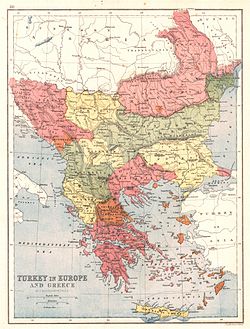- Danube Vilayet
-
ولايت طونه
Vilâyet-i TûnaVilayet of the Ottoman Empire ← 
←
←
1864–1878  →
→
 →
→
 →
→
 →
→1870 map showing the vilayet of the Danube Capital Rusçuk
43°0′N 25°0′E / 43°N 25°ECoordinates: 43°0′N 25°0′E / 43°N 25°EHistory - Established 1864 - Congress of Berlin 1878 The Vilayet of the Danube or Danubian Vilayet (Ottoman Turkish: ولايت طونه, Vilâyet-i Tuna)[1] was a vilayet of the Ottoman Empire from 1864 to 1878.[2] In the late 19th century it reportedly had an area of 34,120 square miles (88,400 km2).[3]
The vilayet was created from the northern parts of Silistria Province along the Danube River and eyalets of Niš, Vidin and Silistra. This vilayet was meant to become a model province, showcasing all the progress achieved by the Porte through the modernising Tanzimat reforms.[4] Other vilayets modelled on the vilayet of the Danube were ultimately established throughout the empire by 1876, with the exception of the Arabian peninsula and the by then semi-independent Egypt.[4]
Contents
Government
Midhat Pasha was the first governor of the vilayet (1864–1868).[4] During his time as a governor, steamship lines were established on the Danube River; the Ruse-Varna railroad was completed; agricultural credit cooperatives providing farmers with low-interest loans were introduced; tax incentives were also offered to encourage new industrial enterprises.[4]
The first official vilayet newspaper in the Ottoman Empire, Tuna/Dunav, was published in both Ottoman Turkish and Bulgarian and had both Ottoman and Bulgarian editors. Its editors in chief included Ismail Kemal and Ahmed Midhat Efendi.[4]
The vilayet had an Administrative Assembly that included state officials appointed by Istanbul as well as six representatives (three Muslims and three non-Muslims) elected from among the inhabitants of the province.[4] Non-Muslims also participated in the provincial criminal and commercial courts that were based on a secular code of law and justice.[4] Mixed Muslim-Christian schools were also introduced, but this reform was abolished after it was met by strong opposition by the populace.[4]
Governors
Governors of the Vilayet:[5]
- Hafiz Ahmed Midhat Shefik Pasha (Oct 1864 - Mar 1868)
- Mehmed Sabri Pasha (Mar 1868 - Dec 1868)
- Arnavud Mehmed Akif Pasha (Feb 1869 - Oct 1870)
- Kücük ömer Fevzi Pasha (Oct 1870 - Oct 1871)
- Ahmed Rasim Pasha (Oct 1871 - Jun 1872)
- Ahmed Hamdi Pasha (Jun 1872 - Apr 1873)
- Abdurrahman Nureddine Pasha (Apr 1873 - Apr 1874)
- Mehmed Asim Pasha (Apr 1874 - Sep 1876)
- Halil Rifat Pasha (Oct 1876 - Feb 1877)
- Oman Mazhar Ahmed (1876–1877)
Administrative divisions
The province included the following sanjaks:[4]
- Sanjak of Tulcea
- Sanjak of Varna
- Sanjak of Ruse
- Sanjak of Turnovo
- Sanjak of Vidin
- Sanjak of Sofia (detached at the beginning of the 1870s)
- Sanjak of Niš (until 1869)
References
- ^ Hathi Trust Digital Library - Holdings: Salname-yi Vilâyet-i Tuna
- ^ Rumelia at Encyclopædia Britannica
- ^ Europe by Éliseé Reclus, page 152
- ^ a b c d e f g h i Encyclopedia of the Ottoman Empire at Google Books By Gábor Ágoston, Bruce Alan Masters
- ^ World Statesmen — Bulgaria
 Subdivisions of the Ottoman Empire
Subdivisions of the Ottoman EmpireEyalets (1363–1864) AfricaAnatoliaAdana · Aidin · Anatolia · Ankara · Archipelago · Diyarbekir · Dulkadir · Erzurum · Hüdavendigâr · Karaman · Karasi · Kars · Kastamonu · Rum · Trebizond · VanAsiaEuropeVilayets (1864–1922) AnatoliaAdana · Aidin · Ankara · Archipelago · Bitlis · Diyâr-ı Bekr · Erzurum · Hüdavendigâr · Istanbul · Kastamonu · Konya · Mamuret-ul-Aziz · Sivas · Trebizond · VanEuropeElsewhereVassals and autonomies Cossack Hetmanate · Cretan State · Crimean Khanate · Khedivate of Egypt · Principality of Moldavia · Sharifate of Mecca · Republic of Ragusa · Eastern Rumelia · Principality of Samos · Serbian Despotate · Duchy of Syrmia · Principality of Transylvania · Tunis Eyalet · Principality of WallachiaSee also the list of short-lived Ottoman provincesCategories:- States and territories established in 1864
- 1878 disestablishments
- Vilayets of the Ottoman Empire in Europe
Wikimedia Foundation. 2010.

